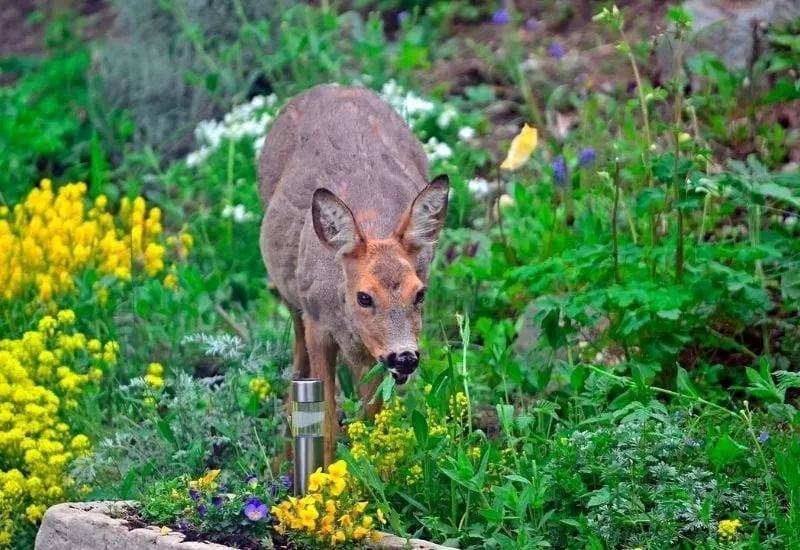
Deer find marigolds unappetizing, and 90% of the times they will walk on without giving them a single bite.
Maybe even more than 90% of the time; and in fact marigold are not just deer-resistant, but even dee repellent to a certain point.
Deer tend to find strong smell and finely textured foliage of marigolds, unappetizing. So planting them around other plants can minimize deer damage and even repel stags, does and fawns from your garden. Very hungry deer, however, will on occasion even eat marigolds, flower, leaf and stems!
But why is it so? And what happens if you are among the unlucky 10%?
We are going to explore all the “deer proof” qualities of marigolds and to take advantage of them, and what happens when even these are too little to save them from these herbivores. All with a top 5 marigold varieties that deer don’t like.
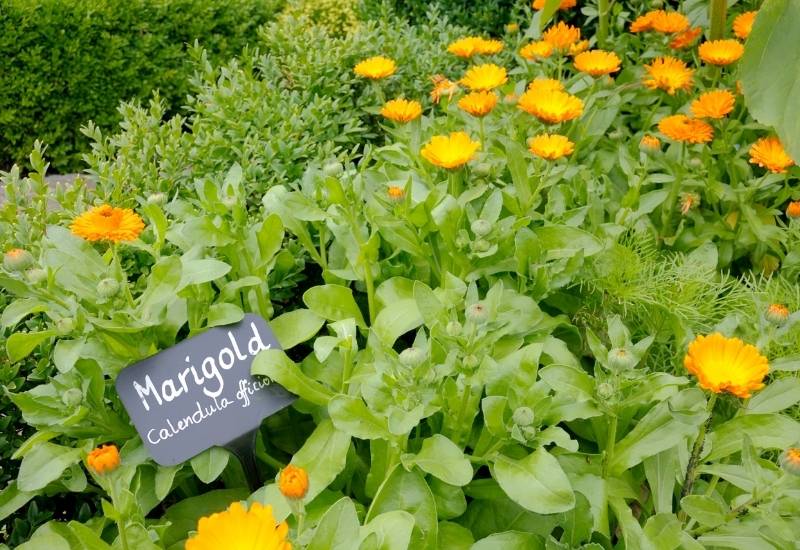
Why Are Marigold Deer Resistant?
Marigold are special flowers indeed; they have a quality that many animals detest, and two qualities that deer loathe. You must have smelled a marigold in the past…
let me ask you, did you like it? I bet the answer is a resounding “NO”! Then you are in agreement with deer.
Marigold foliage, stems and flowers have a strong fragrance that deer do not like. Most Humans don’t like this kind of smell either, like with geraniums. But put yourself in the shoes, (or hooves) of one of our horned friends…
Their sense of smell is 50 times (!!!) better than ours… In fact it’s better than that of dogs. Now imagine that same aroma but 50 times more powerful…
Now you know why deer are not keen on our bright flowers. But there is more… these animals are fussy when it comes to the texture of the leaves and petals they eat.
They like smooth things, so, Hostas are perfect, but Tagetes have that lace like foliage… Not their favorite at all.
So are marigold deer resistant or deer repellent?
Marigolds Between Deer Resistant and Deer Repellent

To start with, let’s look at the difference between deer resistant and repellent.
Marigold is a bit of both. It is resistant because deer will not eat it, most times. But its fragrance is actually a deterrent, a put off to deer. So, if you plant many marigolds, they can even function as a deterrent to horned herbivores visiting your property.
One or two won’t be enough though; you really need to grow quite a few.
Are Marigolds Fully “Deer Proof”
Deer resistant does not mean that deer will never eat the plant. Some plants, however, are literally off limit for our cervine friends. But these are only plants that are toxic or poisonous to them. And marigolds are not in this category.
To be honest and precise, marigolds contain irritating substances, which can affect the membrane of stomach, and they have a very, very bitter taste.
All these characteristics make marigolds very, very deer resistant, in fact, they are among the safest plants to grow if you have a problem with these animals on your land. But they are not all the same…
Are All Marigolds Equally Deer Resistant?
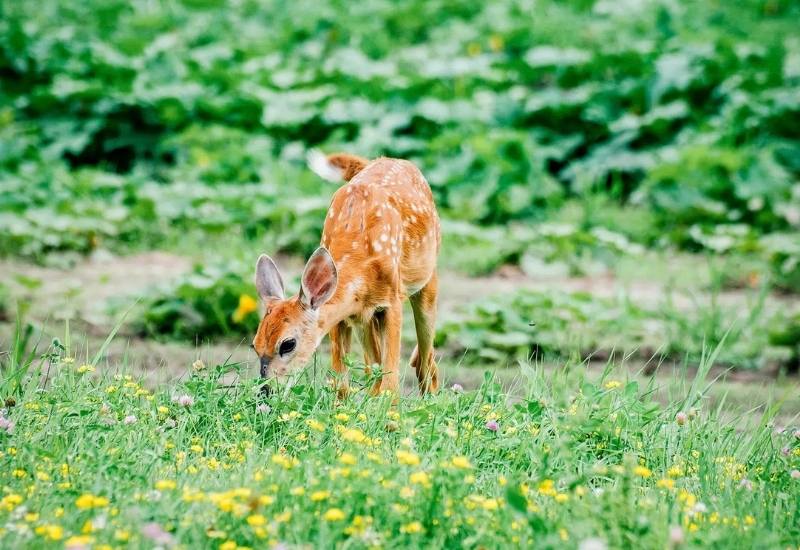
The straightforward answer is, “No, not all marigold varieties are equally deer resistant.”
While most varieties, including the classic French and African marigolds (Tagetes patula and Tagetes erecta) are deer resistant, some like signet marigold (Tagetes tenuifolia) have a sweeter citrus smell and flavor. This is less unappealing to our horned friends, and sometimes they eat them.
But did you know that marigold are not just loathsome to deer?
Many animals are put off by the strong smell of marigolds, not just deer: mosquitoes, flies, slugs, snails, aphids and many other pests. Even rabbits don’t like them,
so, well, take advantage of the situation and use marigolds to keep most unwanted guests off your flower or vegetable beds!
And in fact…
How to Use Marigolds to Keep Deer Off Your Flowers and Vegetables
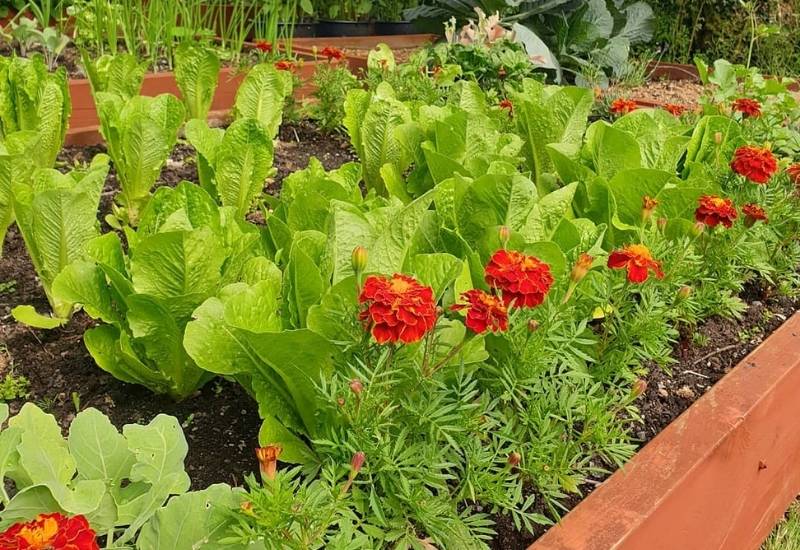
You can use marigolds to defend other plants from hungry deer, and there are a few “tricks of the trade” I would like to share with you…
The key concept is to use the smell, flavor and even texture of these lovely flowers to discourage deer from eating nearby plants. There are two key methods you can use and we are going to see each one in turn.
How to Use Marigolds in the Garden to Repel Deer
We said that if you want to grow marigolds to repel deer, you will need to plant quite a few. And I mean a lot. You need to get their smell so strong that deer think it’s all or almost all they will find on your land, or in your garden.
To make your garden nearly deer proof : mix marigolds with other strong smelling plants, especially lavender, rosemary, sage and geraniums. You will still need to grow lots of these plants, like in large borders, or scatter them all over your garden with thick planting.
This won’t form a 100% deer proof solution, but the strong, mixing and confusing smells will likely send the herd to check out first other places, where the aroma is more suitable to their taste.
How to Mix Marigolds into Flower and Vegetable Beds to Stop Deer
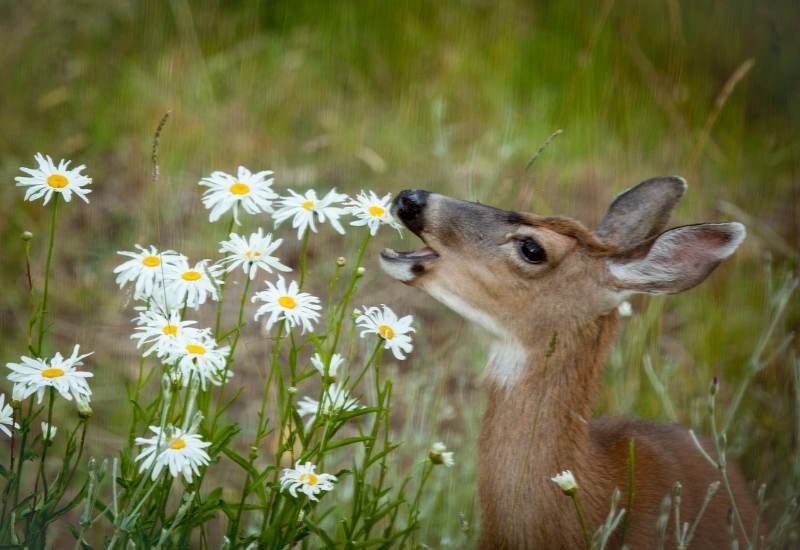
Imagine a doe, stag or fawn that finds your flower bed; it gets close, and it tries to have a bite at your pansies or lettuce, but… It can’t do it without touching, smelling at close range or even eating a parts of your marigolds…
If you plant lost of marigolds in your beds, so that deer cannot insert their muzzles without having a close encounter with them, you will cause them a big discomfort to your these uninvited dinner guests.
The chances are that they will prefer another “restaurant” where service is better than yours… Yet again, do remember that very hungry deer will stop before nothing and eat almost any plant, bar those that are poisonous.
But is there a way we can improve on our marigolds’ deer resistant properties?
How To Keep Deer From Eating Your Marigold Flowers
Yes! You can! And the idea is that there is strength in numbers! Now, if you have a very serious deer problem, you may want to offer some extra safety to your Targets… But let me tell you what I mean by “serious” issue.
So, what can you do if this is your case?
The Ultimate Solution: Deer Barriers
The on,y full permanent solution to deer is to keep them off your property with barriers. For this, you will need either a tall and strong fence (8 feet tall, or 2.4 meters) or a thick and deep hedge with deer resistant shrubs like holly, juniper, cypress, boxwood etc. This needs to have a dense mesh of branches, and it requires time and money, and maintenance…
So, how about of you can’t afford such drastic solutions, even in the short term?
Mix Your Marigolds with Other Deer Resistant Plants to Protect them from Deer
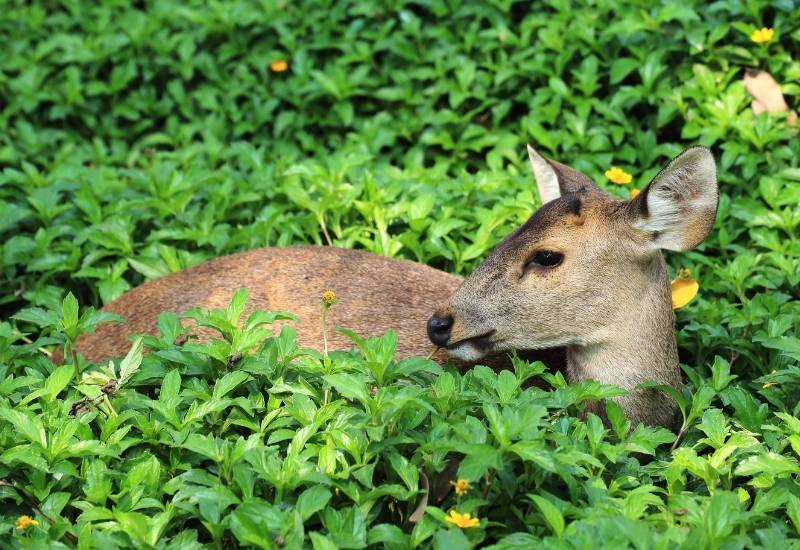
The easiest solution is to provide a totally “stomaching” meal to visiting deer. How can you do this? It’s simple, you can do it with planting.
Mix your Tagetes with other flowers, shrubs and herbs that these animals find disgusting like:
Conversely, avoid planting flowers and vegetables that deer love a lot, like hostas, pansies, roses, lettuce, spinach etc.
If marigolds can be a shield that protect these flowers and leafy veggies against hungry animals in normal circumstances, they can simply become part of their dinner when they are very hungry…
This is why it’s very important that you assess how serious the problem is in your area.
And finally…
Add Extra Repellent Smell to Marigolds to Protect them from Deer
There are literally deer repellent products on the market that you can spray on your plants, including marigolds, to keep deer off them.
But I am going to save you lots of money and teach you how to make a great one at home.
Adapt the dosage to the amount of water you use and repeat the operation every two weeks or so. The garlic smell will disappear in a day for us, but remember?
Deer can smell 50 times better than we do, and they will find the nauseating pong on your flowers for a very long time.
And chili? They literally find it disgusting!
Plant Deer Resistant Marigold Varieties
Now you know what to do with your marigold, here are top five marigold flower varieties which considered to be more resistant to deer.
1: African Marigold (Tagetes erecta)
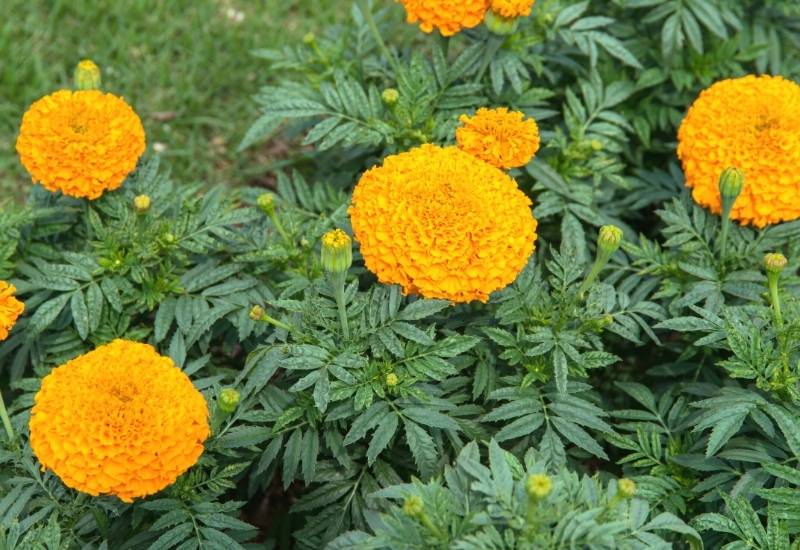
African marigold is one of the strongest smelling varieties, and its leaves are not a deer’s cup of tea because they are segmented into many leaflets.
So you can enjoy the yellow globular blooms of this popular annual variety without worrying about finding tooth marks in the clumps of color in the morning.
This massive bloomer is very low maintenance, strong and easy to grow. Depending on the climate and soil, it can grow into a fairly tall shrub like plants.
For this reason, it can be used even as part of barriers against hungry herbivores. However, it adapts to most soils, but its growth is affected by the type and quality.
2: French Marigold (Tagetes patula)
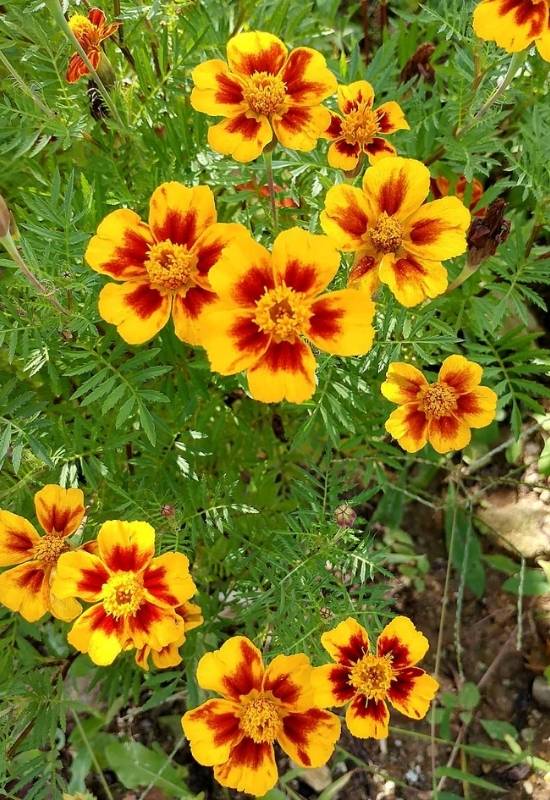
French marigold is one of the most popular Tagetes in the world, and it too has lots of characteristics that deer hate: a strong aroma, and very thinly segmented leaves…
These form very thick and bushy, dark foliage. The flowers are orange and quite large, 2 inches across (5 cm). There are single, double and semi double varieties too.
This is a small variety of marigolds, so it is ideal to mix it in with other little plants to protect them from deer, like pansies, lettuce, spinach etc.
3: Sweetscent Marigold (Tagetes lucida)
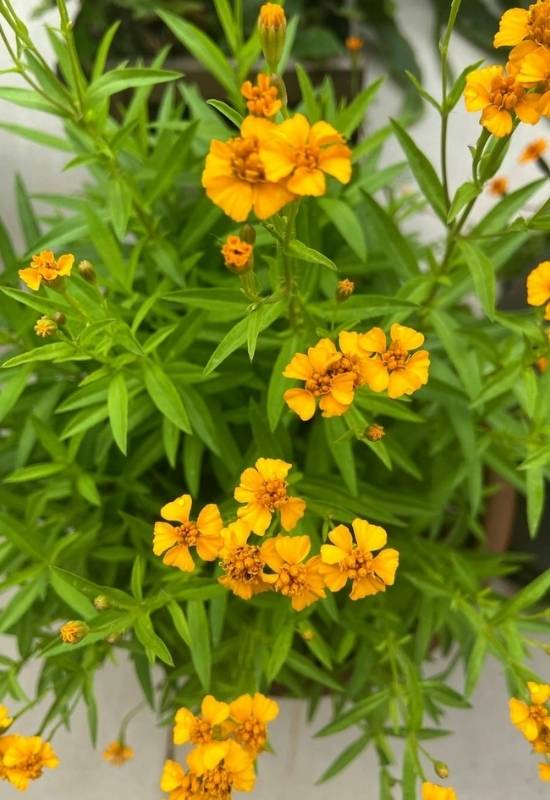
Sweetscent marigold is no sweet smell to deer! It has a strong anise aroma, and the reason is that this is a medicinal variety.
And our horned friends cannot stand plants with medicinal properties… The leaves are bright green, unusually smooth and even glossy, but very aromatic, and the flowers are yellow and wild looking.
Sweetscent marigold is ideal for natural looking settings, like meadows, cottage gardens or even as a presence in vegetable beds and crop gardens that any doe, stag or fawn will find repulsive…
4: Mayan Marigold (Tagetes parryi)
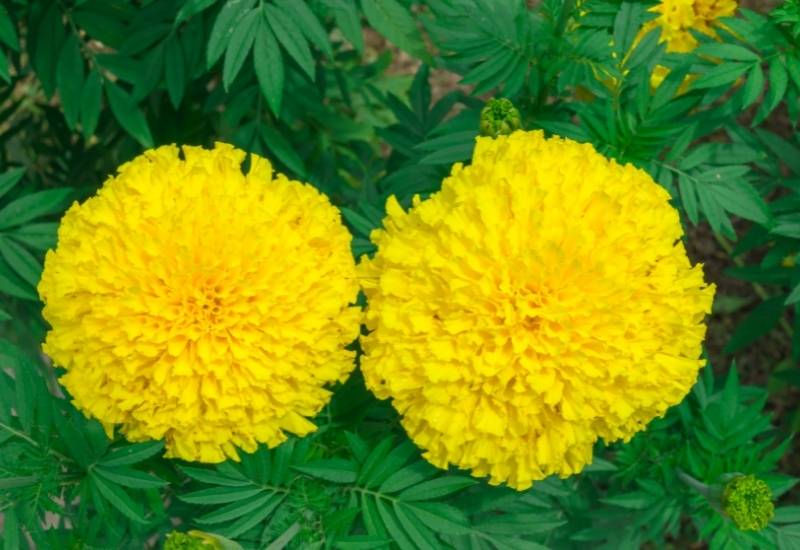
Mayan marigold grows in pastures in Mesoamerica, where herbivores of all sorts seem not touch it – including deer and even goats!
It has pinnate leaves of a fairly bright color and daisy like yellow flowers that grow on top of the finely laced elegant foliage and look up, back to the Sun, which they resemble.
Mayan marigold is not one of the most common garden varieties, and it may be hard to find it on the market.
However, if you do, it is by far one of the best plants to grow in natural and wild looking settings and sleep happy dreams, because virtually no animal will eat it…
5: Mexican Marigold (Tagetes lemmonii)
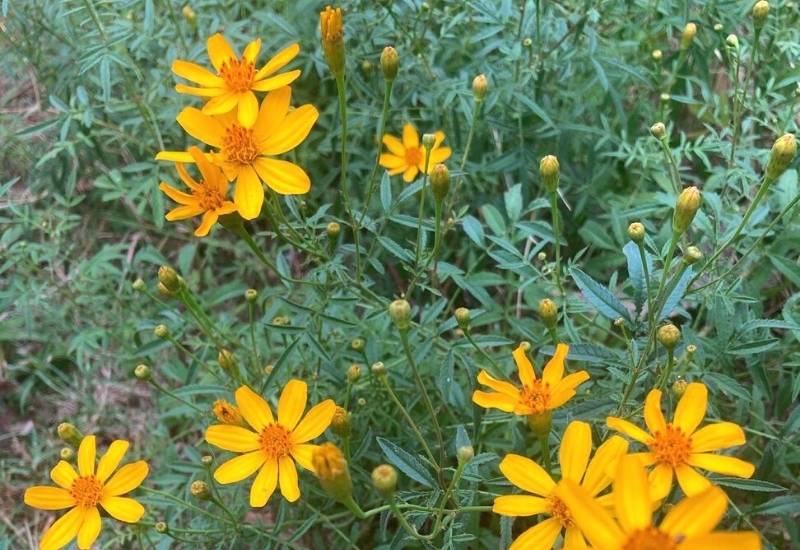
Mexican marigold has a strong musky fragrance which discourages deer from eating it. It becomes particularly strong if you rub the richly textured, dark green and evergreen foliage.
The flowers cover it like a carpet with bright yellow blooms, and they do it at very unusual times, in fall and winter, when days are short.
Mexican marigold is a sprawling variety which is ideal for large effects, like big clumps, flower beds or as ground cover.
It also adapts well to filling in gaps in tall borders and other flower beds, or even as hedging in vegetable gardens and containers.
Deer Free Marigolds and Gardens
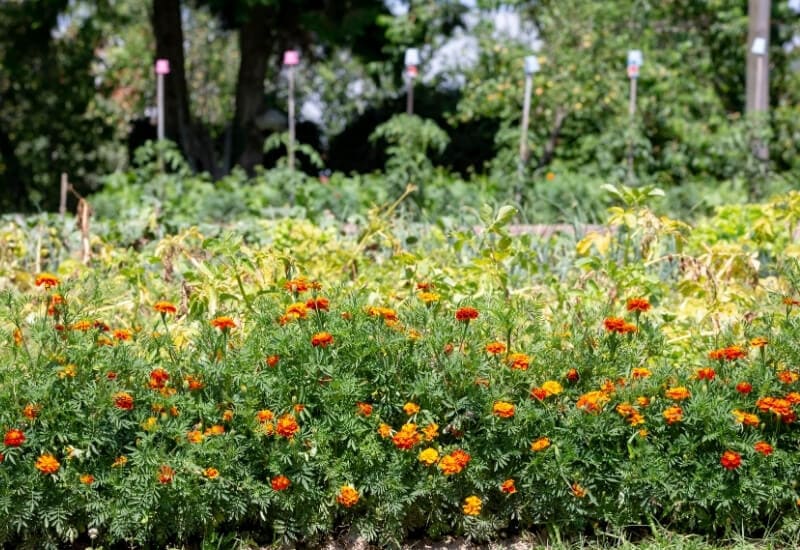
Marigolds are really beautiful flowers, and they are extremely useful to gardeners. They brighten up your green space but they also keep many unwanted guests away, bugs, pests, slugs etc… They are also very deer resistant, and in some cases almost deer proof (Mayan marigold).
You can use them to keep your garden healthy and safe from hungry herbivores with horns, you can even use them to repel these unwelcome four legged visitors, as you now know. But you also know how to protect them even further and which are the best varieties to choose from.
What a beautiful and useful plant indeed!

Written By
Amber Noyes
Amber Noyes was born and raised in a suburban California town, San Mateo. She holds a master’s degree in horticulture from the University of California as well as a BS in Biology from the University of San Francisco. With experience working on an organic farm, water conservation research, farmers’ markets, and plant nursery, she understands what makes plants thrive and how we can better understand the connection between microclimate and plant health. When she’s not on the land, Amber loves informing people of new ideas/things related to gardening, especially organic gardening, houseplants, and growing plants in a small space.
